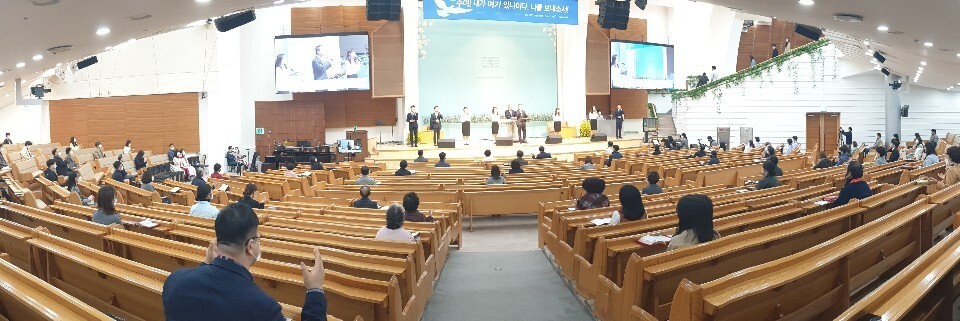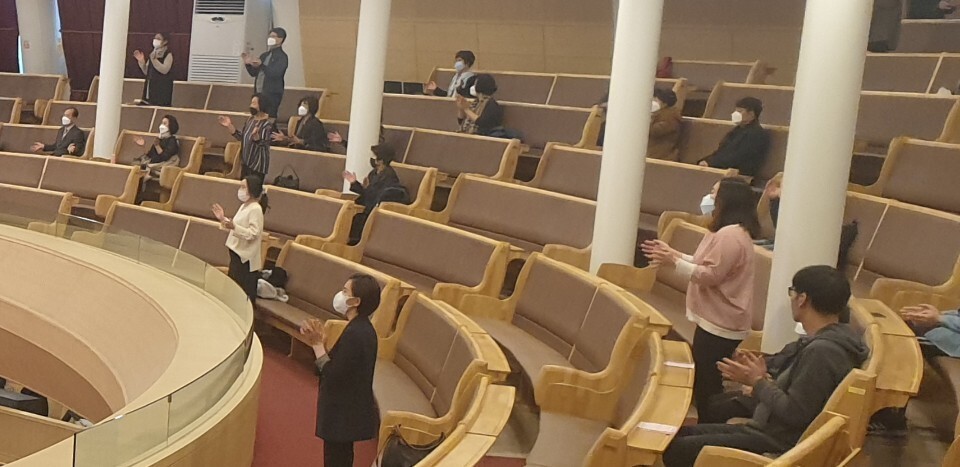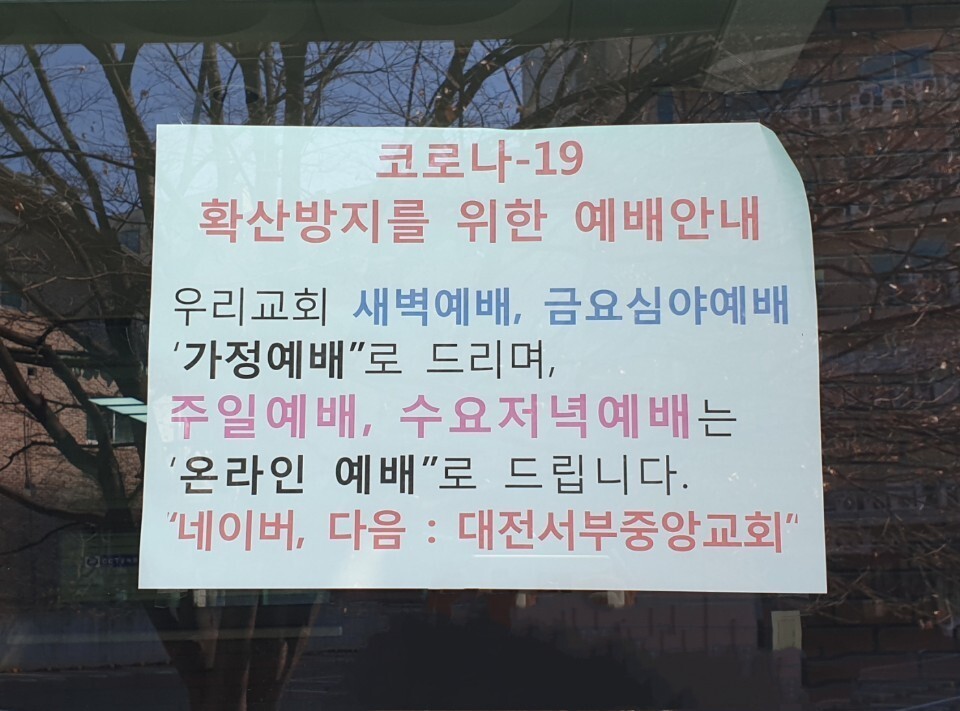hankyoreh
Links to other country sites 다른 나라 사이트 링크
[Reportage] Churches continue to hold services despite government advisories against

In ones and twos, the congregation of “S” church, in Daejeon’s Seo (West) District) came together on the morning of Mar. 22. Children could be seen going into the church, holding their parents’ hands. Most of the congregation members were wearing masks, and there was a thermal camera set up at the entrance to check for fever. Public servants from the city had stopped by the church to ask the leaders to refrain from holding a service in person, but to no avail. “We can’t stop the believers from coming to church,” the head minister said.
The head pastor at the church, surnamed Oh, brought up the Korean War while trying to convince a reporter about the importance of holding physical services. “We kept holding services during the Japanese colonial occupation and even during the Korean War. Services are of immense importance to Christians,” the pastor said.
“We are holding online services, too. But since there are people who want to attend services in person, we can’t just turn them away,” he added.
That said, there was a sharp decrease in the number of people at the service. While typically 2,000 people attend the church’s third Sunday service, at 11 am, there were only 160 or so on Mar. 22, including children and childcare staff.
The scene was much the same at “C” church, in the Hwagok neighborhood of Seoul’s Gangseo District. About 150 people in masks were dotted around the auditorium. This was the only large church in the district to go ahead with a physical service. The church has 8,000 members and typically draws in 3,000 people to its four daytime Sunday services, but on Mar. 22, only 800 people showed up for church.

“I was surprised by how many people came out for church. They’re doing a good job of checking for fevers, but I’m worried about the possibility of asymptomatic people,” a district official said.
On-site services were also being held in Seongnam, Gyeonggi Province — the site of River of Grace Community Church, where 70 people were infected with COVID-19 during services held on Mar. 1 and 8. City officials said that 396 mid-size and small churches held services on Sunday.
South Korea’s central government and local governments asked the public on Mar. 21 to refrain from holding weekend services for two weeks to block the spread of the coronavirus, but as of Sunday, just two days later, many churches around the country were still pushing ahead with on-site services.
Of the 6,490 churches in Seoul, 2,209, or 34%, held on-site services. At the city’s request, members of the Seoul Metropolitan Police Agency accompanied officials as they inspected 1,839 churches.

Daejeon also reported that 700 of its 2,400 churches had held Sunday services. A thousand public servants from city hall and district offices were assigned to inspection teams that went around to churches and asked them to refrain from holding on-site services.
Demonstrators appeared in front of some churches to protest their services. “This is so selfish, when the state has asked you to cooperate democratically. How are you any different from Shincheonji?” yelled an individual surnamed Hur, 40, who had been passing in front of “H” church in Seoul’s Hwagok neighborhood. Several dozen locals wearing white protective gear stood in front of “G” church, in Guro District, urging the church to move its services online.
One reason that some churches are insisting on on-site services may be financial: they want to keep collecting offerings. “Our understanding is that some churches are holding services in person because of financial difficulties resulting from three weeks without services. There were 100 more churches holding services this week than last week,” said an official with the Daejeon metropolitan government.
By Kim Gi-seong, South Gyeonggi correspondent, Song In-geol, Daejeon correspondent, and Choi Ye-rin, Daejeon correspondent and Lee Jeong-gyu, staff reporters
Please direct comments or questions to [english@hani.co.kr]

Editorial・opinion
![[Column] Season 2 of special prosecutor probe may be coming to Korea soon [Column] Season 2 of special prosecutor probe may be coming to Korea soon](https://flexible.img.hani.co.kr/flexible/normal/500/300/imgdb/original/2024/0426/3317141030699447.jpg) [Column] Season 2 of special prosecutor probe may be coming to Korea soon
[Column] Season 2 of special prosecutor probe may be coming to Korea soon![[Column] Park Geun-hye déjà vu in Yoon Suk-yeol [Column] Park Geun-hye déjà vu in Yoon Suk-yeol](https://flexible.img.hani.co.kr/flexible/normal/500/300/imgdb/original/2024/0424/651713945113788.jpg) [Column] Park Geun-hye déjà vu in Yoon Suk-yeol
[Column] Park Geun-hye déjà vu in Yoon Suk-yeol- [Editorial] New weight of N. Korea’s nuclear threats makes dialogue all the more urgent
- [Guest essay] The real reason Korea’s new right wants to dub Rhee a founding father
- [Column] ‘Choson’: Is it time we start referring to N. Korea in its own terms?
- [Editorial] Japan’s rewriting of history with Korea has gone too far
- [Column] The president’s questionable capacity for dialogue
- [Column] Are chaebol firms just pizza pies for families to divvy up as they please?
- [Column] Has Korea, too, crossed the Rubicon on China?
- [Correspondent’s column] In Japan’s alliance with US, echoes of its past alliances with UK
Most viewed articles
- 1‘We must say no’: Seoul defense chief on Korean, USFK involvement in hypothetical Taiwan crisis
- 2N. Korean delegation’s trip to Iran shows how Pyongyang is leveraging ties with Moscow
- 3‘Weddingflation’ breaks the bank for Korean couples-to-be
- 4Korea sees more deaths than births for 52nd consecutive month in February
- 5[Editorial] New weight of N. Korea’s nuclear threats makes dialogue all the more urgent
- 6[Column] Has Korea, too, crossed the Rubicon on China?
- 7[Column] Park Geun-hye déjà vu in Yoon Suk-yeol
- 8[Guest essay] The real reason Korea’s new right wants to dub Rhee a founding father
- 9Amnesty notes ‘erosion’ of freedom of expression in Korea in annual human rights report
- 10[Reportage] On US campuses, student risk arrest as they call for divestment from Israel